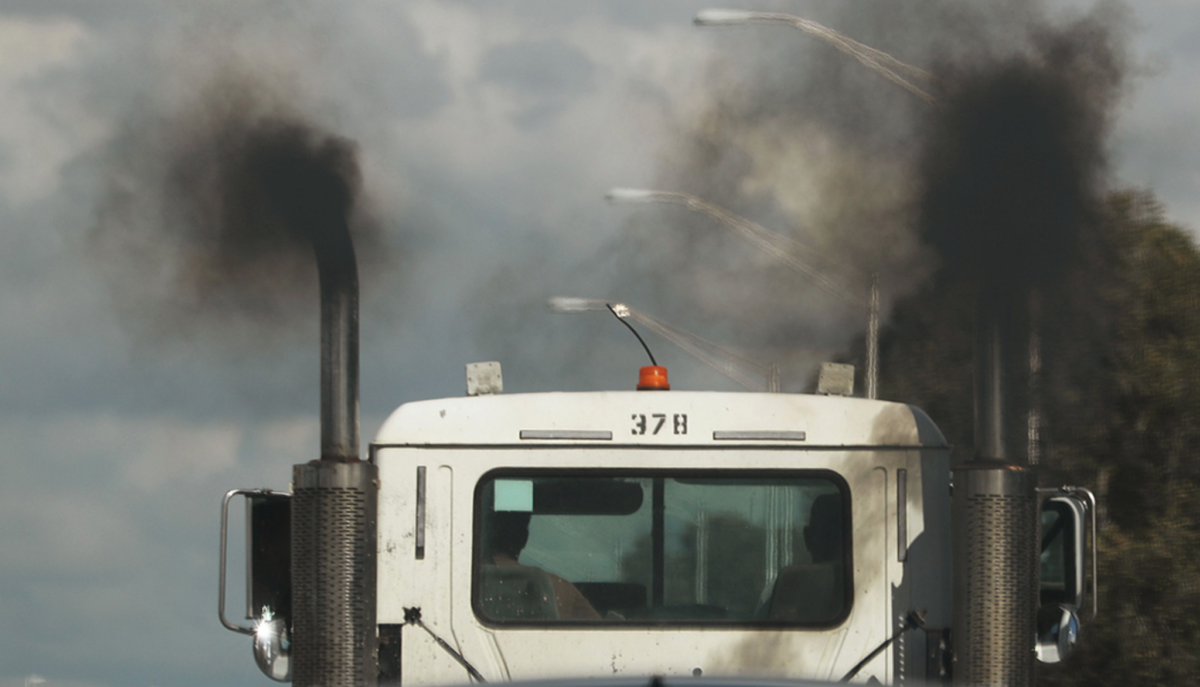Staff Report –
WASHINGTON, D.C. — The Biden Administration announced the strongest-ever national clean air standards to cut emissions from trucks, vans and buses beginning with model year 2027, the first update to clean air standards for trucks in more than 20 years.
According to the announcement from the Environmental Protection Agency, the new standards are more than 80 percent stronger than current standards, and will move America’s highly polluting heavy-duty trucking fleet towards low-carbon and electric technologies.
The agency also said historic investments from President Biden’s Inflation Reduction Act and Bipartisan Infrastructure Law are accelerating innovation in zero-emissions truck technology, expanding access to clean school and transit buses, and training workers to install and maintain charging infrastructure.
“EPA is taking significant action to protect public health, especially the health of 72 million people living near truck freight routes in America, including our most vulnerable populations in historically overburdened communities,” EPA Administrator Michael S. Regan said in making the announcement. “But we’re not stopping there.
“This is just the first action under EPA’s Clean Trucks Plan to pave the way toward a zero-emission future,” he said. “These rigorous standards, coupled with historic investments from the Inflation Reduction Act and the Bipartisan Infrastructure Law, will accelerate President Biden’s ambitious agenda to overhaul the nation’s trucking fleet, deliver cleaner air, and protect people and the planet.”
The final standards will reduce deadly smog and soot from new heavy-duty trucks starting with Model Year 2027. EPA estimates that by 2045, the rule will result in the following annual public health benefits:
* Up to 2,900 fewer premature deaths
* 6,700 fewer hospital admissions and emergency department visits
* 18,000 fewer cases of childhood asthma
* 3.1 million fewer cases of asthma symptoms and allergic rhinitis symptoms
* 78,000 fewer lost days of work
* 1.1 million fewer lost school days for children
* $29 billion in annual net benefits
Relative to current rules, the new standards are more than 80 percent stronger, increase useful life of governed vehicles by 1.5–2.5 times, and will yield emissions warranties that are 2.8–4.5 times longer, the agency says.
“This final rule includes provisions for longer useful life and warranty periods,” EPA says. “These provisions guarantee that as target vehicles age, they will continue to meet EPA’s more stringent emissions standards for a longer period of time.”
The rule also requires manufacturers to better ensure that vehicle engines and emission control systems work properly on the road. For example, manufacturers must demonstrate that engines are designed to prevent vehicle drivers from tampering with emission controls by limiting tamper-prone access to electronic pollution controls.
This rulemaking is based on a robust, complete technical record consistent with the authority set forth in the Clean Air Act. EPA engaged a wide variety of stakeholders, including impacted communities, Tribal, state and local governments, industry leaders, environmental organizations, environmental justice organizations, labor groups, and others to develop final standards that are as strong as possible, take effect as soon as possible and will last as long as possible.
Accelerating a Zero Emissions Future
Today’s announcement is the first of three major actions being taken under EPA’s Clean Trucks Plan.
In the coming months, EPA intends to release the proposals for the remaining two steps. These include the proposed “Phase 3” greenhouse gas (GHG) standards for heavy-duty vehicles beginning in Model Year 2027, as well as the proposed multipollutant standards for light- and medium-duty vehicles beginning in Model Year 2027. These additional rulemakings will consider recent Congressional action, including historic resources for electrification from the Inflation Reduction Act and the Bipartisan Infrastructure Law that EPA anticipates will lead to swift adoption of zero-emission vehicle technologies.
Taken together, these rulemakings will put in place stringent long-term standards that will reduce dangerous smog, soot, and climate pollution from heavy-duty vehicles.
Now that the Agency has taken this final action on reducing NOx emissions nationally from Heavy-Duty trucks, EPA will complete the assessment of the technical and legal record before the Agency and prioritize issuing decisions on the three pending Heavy-Duty program waiver requests from the State of California in early 2023.
Reaction
According to coverage in The Washington Post, the regulation marks the first time the federal government has tried to crack down on emissions from these diesel-powered vehicles in over two decades, and it is aimed at improving the lives and health of Americans who live alongside highways, ports and sprawling distribution centers. Exposed to heavy diesel exhaust, these predominantly poor, Black and Latino communities suffer higher rates of asthma, heart disease and early death.
Public health advocates praised the new regulation, saying it was likely to result in real health benefits.
But the policy was met with disappointment by some environmental groups and liberals, who had pushed the EPA to be far tougher. It is not as stringent as California’s pollution regulations, which activists had held up as a model for federal policy.
The EPA said the new rule would require truck makers to reduce vehicles’ emissions of lung-damaging nitrogen dioxide 80 percent below the current standard. California’s rule calls for a 90 percent cut.
The new policy is a “missed opportunity,” said Dave Cooke, a senior vehicles analyst with the Union of Concerned Scientists. “The final standards announced by EPA do not reflect the full potential of the solutions available to tackle smog-forming and particulate pollution from trucks, including electrification.”
Environmental justice advocates said they had hoped for a rule that would push fleet owners to replace their diesel-burning trucks and buses with zero-emission alternatives.
The new pollution policy is a “short-term solution,” said José Miguel Acosta Córdova, senior transportation policy analyst for the Chicago-based Little Village Environmental Justice Organization. Little Village, a predominantly Latino neighborhood in the city’s southwest, sits near major highways and railroads and has some of the dirtiest air in Chicago.
“There’s no amount of pollution that’s good — any exposure is bad — even if they’re cleaner trucks than they previously were,” Córdova said.
In a setback for California’s ability to set pollution standards that are tougher than the federal limits, the EPA also announced that it would postpone making a decision until early next year about whether to grant the state’s request for the waivers it needs to enforce its own policies. The delay leaves the state’s truck pollution rules in limbo and affects the other states that have already signed on to follow California’s regulations.
Tuesday’s finalized rule differs from one the EPA proposed earlier this year, and in writing it, the agency appears to have leaned into compromise.
Its proposal in March detailed two possible paths — one closer to California’s rule and a weaker alternative favored by truck makers. In an interview, Regan said the final regulation has pieces of both “to ensure the final standards are as strong as possible, take effect as soon as possible and will last as long as possible.”
As a result, the agency estimates the new rule will cut nitrogen dioxide from heavy-duty trucks by 48 percent by 2045. The original proposal would have reduced emissions by 60 percent.
“The EPA landed in the right place,” said Margo Oge, a former senior official at the agency. Oge said critics of the policy should remember that the EPA’s work is not done. The new rules the agency is working on to cut planet-warming emissions from heavy-duty trucks are expected to accelerate purchases of zero-emission trucks, reducing diesel pollution even more.
“The agency now has to roll up its sleeve and deliver something significant and big, and if they don’t, it’s going to be a big disappointment,” Oge said.
The agency estimated that the new rule would deliver significant economic benefits, outweighing its costs by about $29 billion each year.
An analysis by the nonprofit International Council on Clean Transportation found that while tighter truck pollution standards would help people across the nation, Midwestern and Southern states stand to benefit the most, relative to their size, because of their busy highways and large concentrations of people living nearby.
Exactly what the new rule will mean for neighborhoods exposed to heavy diesel exhaust is uncertain. Experts said that whether the regulation makes deep cuts to emissions depends in large part on whether it closes some of the loopholes that have weakened previous federal rules.
The new rule does include an important change: For the first time, it regulates the pollution emitted from diesel-burning engines at low speeds, while idling, and in stop-and-go traffic. These emissions, which are most likely to affect people living in neighborhoods choked with truck traffic, were previously excluded.
But truck makers and their lobbyists have pushed the EPA to grant them other allowances that would make it easier for them to meet the new standards on paper, even if they exceed them in the real world.
The Truck and Engine Manufacturers Association, an industry group, warned the Biden administration against setting the bar too high, arguing that compliance would increase trucks’ cost, causing buyers to delay making new purchases and leaving older, dirtier, diesel-burning vehicles on the road for years.
In a statement Tuesday, EMA President Jed Mandel said the new rule was “very stringent and will be challenging to implement.”
“Ultimately, the success or failure of this rule hinges on the willingness and ability of trucking fleets to invest in purchasing the new technology to replace their older, higher-emitting vehicles,” he added.
The United Auto Workers had also expressed concerns. The union urged the administration to adopt a less strict standard for nitrogen dioxide out of concern that higher truck prices would cost its members jobs.
If the EPA grants California’s waiver requests next year, giving the state the ability to enforce its own limits on truck pollution, truck manufacturers are expected to sue. Industry representatives have said they would prefer to follow one national standard, and they have tried to discourage other states from adopting California’s tougher rules.
For their part, California officials did not directly criticize the EPA for delaying action but said in a statement, “We eagerly look forward to formal EPA approval of our existing standards that reduce pollution in California and other states.”
Diesel-burning trucks and buses are major polluters. Although their emissions have declined over the decades as technology improved, of all the vehicles on the nation’s roadways, they are still the single biggest contributor to unhealthy air. The nitrogen dioxide they release reacts with chemicals in the atmosphere to create other pollutants, such as ozone and fine particles, that harm human health.
This year, an American Lung Association report estimated that switching to zero-emission trucks would prevent 66,800 premature deaths over the next 30 years.
___
If you support truth in reporting with no paywall, and fearless writing with no popup ads or sponsored content, consider making a contribution today with GoFundMe or Patreon or PayPal.














